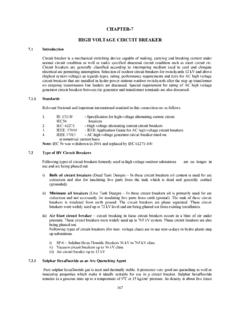Transcription of CHAPTER- 11 GENERATOR TECHNICAL & EXCITATION …
1 CHAPTER- 11. GENERATOR TECHNICAL & EXCITATION system specification . Specifications Typical specifications of a large vertical peaking hydro generators (umbrella/semi umbrella) with static EXCITATION system detailing the requirements of various components of generators and exciter, applicable standards, performance guarantees, erection, testing and commissioning requirements are given below. ( specification for small and other GENERATOR may be modified). Scope (i) Vertical shaft synchronous generators . kW at .. PF with closed system of ventilation with surface air cooler.
2 (ii) Static EXCITATION system including EXCITATION cubicle and voltage regulating equipment and accessories. (iii) Special provision for peaking operation brake dust collection system (if required). (iv) GENERATOR transformer connection (Isolated Phase bus duct/segregated phase bus duct). (v) Neutral grounding equipment. (vi) Surge protection equipment, potential transformer. (vii) GENERATOR bus bar current transformers (viii) Carbon dioxide fire extinguishing equipment (ix) Lubrication system (if required). (x) Oil water and air piping with valves and fitting.
3 (xi) Instrumentation, control and safety devices. Applicable Standards Latest edition of the following standards shall be applicable. IEC-34-1: 1983 Rotating Electrical Machines Rating and Performance IEC-34-2A-1972 - Rotating Electrical Machines Methods for determining losses and efficiency of electrical machinery from tests (excluding machines for traction vehicles IEC-34-5-1991 Classification of degrees of protection provided by enclosures for rotating electrical machines (IP Code). IEC-85-1987 - Classification of materials for the insulation of electrical machines ANSI Requirements for Salient-Pole Synchronous generators and GENERATOR /Motors for hydraulic Turbine Applications , IEEE No.)
4 115 Test Procedures for Synchronous Machines , IS-4722 1992 Rotating electrical machines IS-325 1996 Three phase induction motor IS-8789 1996 Values of performance characteristics for three phase induction motors IS-4889-2002 Method of determination of efficiency of rotating electrical machines IEEE std. , IEEE standard definitions for EXCITATION systems for synchronous machines IEEE std. TM -1990, IEEE Guide for identification, testing, and evaluation of the dynamic performance of EXCITATION control system Type and Rating The GENERATOR to be furnished under these specifications shall be umbrella/semi umbrella type with thrust bearing at bottom and direct driven by the turbine.
5 The turbine GENERATOR shall be designed as a complete unit with all the necessary supports, access, lubrication cooling, lighting, ventilation system , fire protection, 261. dehumidifying, (for bulb generators ) draining, wiring, piping and all other auxiliary systems. The GENERATOR shall be supplied with a complete static EXCITATION and voltage regulation system . Except as otherwise provided, major components of the GENERATOR shall be designed by the Contractor. This shall not preclude a wholly-owned subsidiary from utilizing the design of its parent company. The rating of the GENERATOR shall be as follows.
6 The generators shall be suitable for peaking operation requiring daily starting and stopping schedules (if required). (a) Capacity kVA. A net capacity of .. kVA at rated conditions is required. The GENERATOR nameplate rating shall reflect the necessary additional capacity to supply the EXCITATION equipment. (b) Power factor . lagging (c) Frequency 50 cycles (d) Number of phases 3. (e) Voltage between phases, rated (kV) 11 kV or higher (f) Speed (RPM) To match turbine speed (g) Stator winding connections Star, (suitable both for Grounded or ungrounded operation).
7 (h) EXCITATION voltage, not to exceed . VDC. Rating, tests and characteristics shall be in accordance with the latest IEC IEEE Standards ANSI Requirements for Salient-Pole Synchronous generators and GENERATOR /Motors for hydraulic Turbine Applications , IEEE No. 115 Test Procedures for Synchronous Machines , each as they apply, unless otherwise definitely specified. The GENERATOR shall be designed in accordance with best International practice, with liberal factors of safety, and for continuous operation at 100 percent rated kVA at rated voltage, power factor and frequency.
8 The following paragraphs, prescribe the minimum requirements for one GENERATOR , but these requirements shall apply also to all generators furnished under these specifications. Similar parts of the GENERATOR shall be of the same materials and workmanship and insofar as practicable, shall be interchangeable. GENERATOR shall be designed for peaking operation requiring starting and stopping schedule every day. Special provision for braking collecting brake dust shall be made so that maintenance is minimized (if required). generators shall be designed to run as synchronous condenser (if required).
9 Electrical Characteristics Each GENERATOR shall have the following principle characteristics. 1. Rated continuous rating at .. lagging power factor and at normal rated terminal voltage MVA. 2. Continuous overload capacity 10 %. 3. Terminal voltage at which the maximum . Continuous rating must be achieved (kV). 4. Minimum terminal voltage under 10 % lower than the Operating continuous with unloaded system normal rated voltage 5. EXCITATION at maximum leading kVA Not less then 12 %. expressed as percentage of that required at rated output and power factor 6. Terminal voltage at which the maximum 5 % higher then the Continuous rating must be achieved normal rated voltage 7.
10 Short circuit ratio on rated kVA 262. Base, not less then 8. Telephone harmonic factor (THF) of the line-to-line Terminal voltage as measured according to IEC 34-1. not more than 9. Efficiency at kVA .. power factor . %. lagging at normal rated voltage and frequency not less then percent 10. Normal exciter response (as defined in (after study). IEEE std. ) for the exciter, not less then 11. Ceiling voltage of exciter when connected To suit above ratio to the GENERATOR field and with rated exciter current delivered (80 degree C). 12. Line charging capacity of the GENERATOR .



